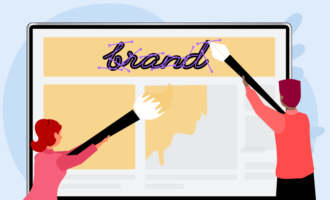Great examples of brand guidelines
We live in a world surrounded by brands, and these days, they’re visible through far more than just logos and signage. Brand visual identity is a language that encompasses the aesthetics we associate with a company and its products, expressed through color palettes, imagery used in commercials, ads, and social media, and even physical spaces. Whenever you shop at a specific store, you’re immersed in a brand experience.
Apple is a great example. The company has elevated its iconic stores to multifunctional destinations where you can learn about new products, get software tutorials, see guest speakers, and get help from the Apple Genius Bar.
Best of all, every Apple Store is a clean, minimalist, one-of-a-kind environment that has become synonymous with the Apple brand itself. Previously, that kind of experience was only reserved for luxury brand customers, but Apple brought it to the mainstream marketplace.
These types of experiences don’t just happen by magic. Brand visual identity only becomes visible when a business strictly adheres to brand guidelines.
The basics of brand guidelines
Put simply, brand guidelines are an overview of a company’s visual assets with instructions on how they should be used. Companies summarize these rules in a document often called a brand style guide. These guides detail every rule for using visual assets, such as the spacing between letters in the logo, what colors can appear together, and even store layout requirements.
The brand style guide is, of course, an internal document used to communicate rules to stakeholders as well as third-party vendors like agencies. Increasingly, a business also will give its brand style guide to the media or make it available to consumers. At Jotform, we released parts of our guidelines after our big brand refresh.
The best brand guideline examples
With all the visual assets required, creating a brand visual identity has become increasingly complicated. The creatives responsible for these identities have become more interested in showing off their work. Here are some of the best brand guideline examples.
1. Netflix
Netflix has created one of the most viewed logos in the world, with its iconic N playing at the end of every trailer and throughout its interface. With more than 209 million paid subscribers, the company estimates that customers clock more than 200 million hours a day on the platform.
To streamline asset delivery to the media — and to show off its creative chops — the company has created a portal for its brand assets, allowing viewers to study the different iterations of the logo as well as best practices for using the materials.
2. Instagram
In today’s digital world, even the channels we use to communicate have their own brands. Instagram excels at making its brand guideline example transparent and accessible. This ensures people use it right without any formatting issues.
On the Instagram brand page on Meta (Instagram’s parent company), designers provide detailed outlines of how visual assets should and shouldn’t be used, with convenient green checkmarks and red Xs, respectively.
3. Facebook
Facebook’s brand guidelines page features assets and basic instructions on how to use them but goes a step further in specifying how people should speak about the company.
As one of the original mainstream social media companies, Facebook was instrumental in shaping the way we talk about social media. Its brand style guide specified how to talk about “likes” and “follows” correctly, highlighting appropriate phrases like “Become a fan on Facebook” instead of “Follow us on Facebook.”
4. Uber
Uber is an impressive example of a brand growing far beyond its original concept. What started out as a groundbreaking rideshare platform has evolved into a meal delivery service as well as a shipping logistics provider and vehicle rental destination.
Uber is another of the more unique brand guideline examples, as it recontextualizes the brand as being made up of systems instead of assets. Still, the site offers a comprehensive array of materials, including logos, document templates, icons, and even media-approved photos.
5. New York City
New York City is “the city that never sleeps,” the “big apple,” and the “capital of the world.” It’s also a brand, and it provides one of the most surprising brand guideline examples on this list.
In typical government fashion, this unusual brand style guide explains that its purpose is to unify the city’s online brand identity and provide detailed instructions on how to properly use it. In addition to the logo and the explanation behind it, the guide also outlines the city’s unique voice.
One way to maintain brand consistency: Jotform
Running a business is incredibly demanding, and maintaining your brand’s consistency across channels is easier said than done. Fortunately, online forms can automate many time-consuming tasks to help you keep track of your brand’s visual identity, including the creation of your own brand guidelines.
Jotform boasts a library of more than 10,000 form templates that can streamline every aspect of your business, from conducting surveys to sending invoices to designers.
You can also use these forms to gather information from third parties and customers. Because each form is completely customizable, you never have to sacrifice brand consistency for convenience and productivity, keeping your brand easily recognizable and appealing.













Send Comment: